Congratulations to Hui-jun Zhou and Guan-wen Yang for their recent publication on ACS nano
Homoporous membranes fabricated by self-assembled block copolymers (BCPs) have gained growing attention for their easy availability of well-ordered nanostructures for precise separation. However, it remains a challenge to improve the mechanical integrity, hydrophilic properties, and pore functionalities of the existing systems. To this end, we report an organic–mineral composite hybrid nanoporous BCP membrane with attractive superhydrophilicity, mechanical stability, and fouling-resistance derived from a bioinspired block copolymer, poly(propylene carbonate)-block-poly(4-vinylcatechol acetonide) (PPC-b-PVCA). The key advances include the following. (1) The PPC minor block is qualified as sacrificial domain because of its alkali sensitivity for generating monodisperse nanopores. (2) The PVCA matrix block contains the catechol groups, which enables the formation of inorganic layer via a biomineralization process, thus producing an organic–mineral composite nanoporous BCP membrane with attractive superhydrophilicity, mechanical stability, and fouling resistance. A ∼200 nm thickness BCP film with monodisperse through-pores of 12 nm diameter cylinders oriented perpendicularly to a supporting microfiltration membrane is fabricated by sequential blade-casting, solvent annealing, hydrolysis sacrificial block, and biomineralization process. The mechanical stability, high water flow (114 L m–2 h–1 bar–1), size fractionation of nanoparticles, as well as protein antiadsorption performance make the strategy provided here hold the promise of affording an advance platform for filtration, catalysis, and drug delivery.


.png)